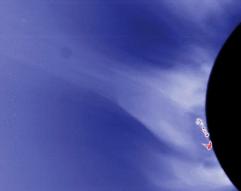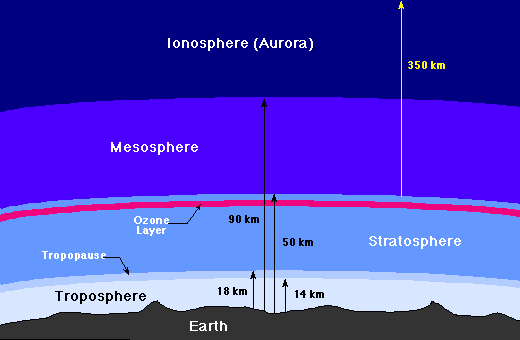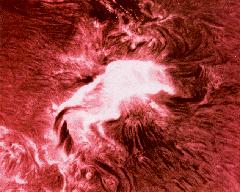Sun-Earth Connection
There are certain occurence observed during solar maxima and minima. Since sunspots number indicates the activity level of the Sun (which in turns indicate when is solar minima and maxima), there are certain occurences observed during periods of minimum and maximum number of sunspots.
Here we will attempt to explain these occurences. The explantions will cover what constitutes a solar wind; what solar flare and corona mass ejection are; and the composition of the Earth's atmospheres. Thereafter -in the next few sections- we will explore the phenomenon observed, and their effects on our planet Earth and us.
Solar Wind and the Earth's Atmosphere
What is a Solar Wind?
| The outermost region of the Sun, Corona, is so hot that the Hydrogen and Helium can escape gravitational attraction and form a steadily streaming outflow of material called the solar wind. Because of its high temperature and constant illumination by the Sun, solar wind is fully ionized plasma-matter in the known universe can be classified in terms of four states: solid, liquid, gaseous, and plasma. (However, the concept of plasma will not be explored here). The solar wind plasma capable of conducting electrical current and carrying a large amount of kinetic and electrical energy, surrounds our planet, interferes with the Earth's atmosphere and hence brings upon impact on us, the habitants of the planet. |
|
 |
The Earth's Atmosphere
The present composition of the atmosphere is 79% nitrogen, 20% oxygen, and 1% other gases. The atmosphere of the Earth may be divided into several distinct layers, as the following figure indicates:

The Troposphere
The troposphere is where all weather takes place; it is the region of rising and falling packets of air. The air pressure at the top of the troposphere is only 10% of that at sea level (0.1 atmospheres). There is a thin buffer zone between the troposphere and the next layer called the tropopause.
The Stratosphere and Ozone Layer
Above the troposphere is the stratosphere, where the flow of air is mostly horizontal. The thin ozone layer in the upper stratosphere has a high concentration of ozone, a particularly reactive form of oxygen. This layer is primarily responsible for absorbing the ultraviolet radiation from the Sun.
The Mesosphere and Ionosphere
Above the stratosphere is the mesosphere and above that is the ionosphere, where many atoms are ionized (have gained or lost electrons so they have a net electrical charge). The ionosphere is very thin, but it is where aurora takes place, and is also responsible for absorbing the most energetic photons from the Sun, and for reflecting radio waves, thereby making long-distance radio communication possible.
The structure of the ionosphere is strongly influenced by the charged particle wind from the Sun (solar wind), which is in turn governed by the level of solar activity.
Sunspots, Flares, and Coronal Mass Ejections
Sunspots and Solar Flares
A flare is defined as a sudden, rapid and intense variation in brightness. Solar flares are tremendous explosions on the surface of the Sun. They occur when magnetic energy that has built up in the solar atmosphere is suddenly released, at near sunspots, usually along the dividing line (neutral line) between areas of oppositely directed magnetic fields:
 |
|
Legend:
blue lines = neutral lines between areas of oppositely directed magnetic fields
bright orange area = flare; lies along a section of the neutral line
|
Flares release energy in many forms - electro-magnetic (Gamma rays and X-rays), energetic particles (protons and electrons), and mass flows:
- With the release of a solar fare, radiation is emitted across virtually the entire electromagnetic spectrum, from radio waves at the long wavelength end, through optical emission (lights visible to human eyes), to x-rays and gamma rays at the short wavelength end. The amount of energy released is the equivalent of millions of 100-megaton hydrogen bombs exploding at the same time!
- As the magnetic energy is being released, particles, including electrons, protons, and heavy nuclei, are heated and accelerated in the solar atmosphere. This magnetic energy is ten million times greater than the energy released from a volcanic explosion but is less than one-tenth of the total energy emitted by the Sun every second.
|
Given the magnitude of the energy released; scientists classify solar flares according to their x-ray brightness. There are 3 categories:
~> X-class flares are big; they are major events that can trigger planet-wide radio blackouts and long-lasting radiation storms.
~> M-class flares are medium-sized; they generally cause brief radio blackouts that affect Earth's polar regions. Minor radiation storms sometimes follow an M-class flare.
~> C-class flares are small with few noticeable consequences here on Earth. |
|

click here for a bigger view |
The frequency of flares coincides with the Sun's eleven years cycle. When the solar cycle is at a minimum, active regions are small and rare; few solar flares are detected. These increase in number as the Sun approaches the maximum part of its cycle.
Corona Mass Ejections (CME)
Solar flares extend out to the layer of the Sun called the corona. The corona is the outermost atmosphere of the Sun, consisting of highly rarefied gas and CMEs are huge bubbles of gas threaded with magnetic field lines that are ejected from here. It was once thought that CMEs are initiated by solar flares; although the solar flares accompany some, it is now known that most CMEs are not associated with the flares. Frequency of CMEs also coincides with the Sun's eleven years cycle. During period of solar minimum (when few sunspots are seen), we observe about one CME a week.


pic to left: coronal of the sun view during an eclipse
pic to right: the SOHO satelite ultra-violet image of the CME
Both solar flares and coronal mass eruptions typically drive shock waves that produce energetic particles through space, i.e. solar winds. While when CME collides with the Earth, it can excite a geomagnetic storm causing a worldwide disturbance of the Earth's magnetic field, solar flares, on the other hand, directly affect the ionosphere, both therefore, bring about impacts to the Earth.





